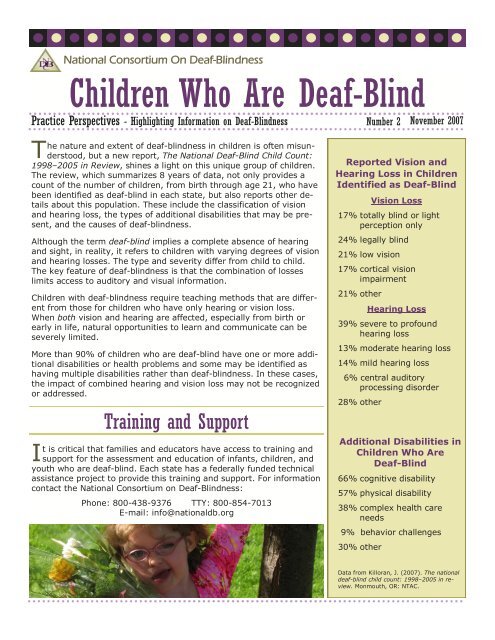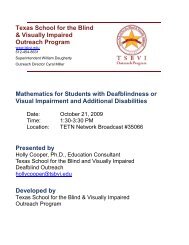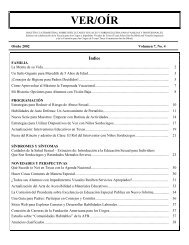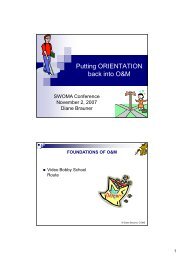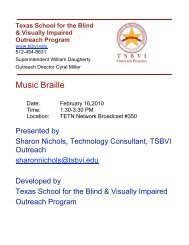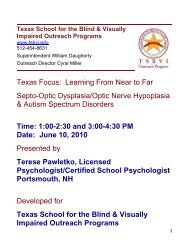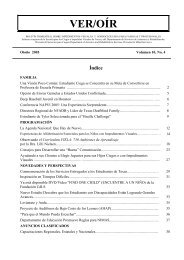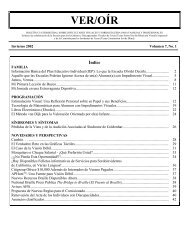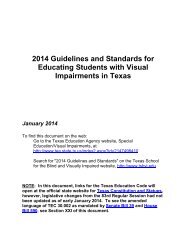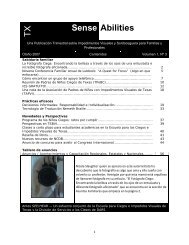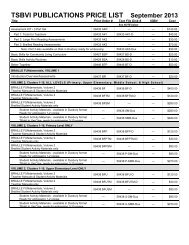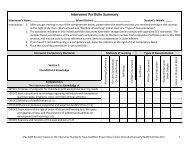Children Who Are Deaf-Blind - National Consortium on Deaf ...
Children Who Are Deaf-Blind - National Consortium on Deaf ...
Children Who Are Deaf-Blind - National Consortium on Deaf ...
- No tags were found...
Create successful ePaper yourself
Turn your PDF publications into a flip-book with our unique Google optimized e-Paper software.
<str<strong>on</strong>g>Nati<strong>on</strong>al</str<strong>on</strong>g> <str<strong>on</strong>g>C<strong>on</strong>sortium</str<strong>on</strong>g> On <str<strong>on</strong>g>Deaf</str<strong>on</strong>g>-<str<strong>on</strong>g>Blind</str<strong>on</strong>g>ness<br />
<str<strong>on</strong>g>Children</str<strong>on</strong>g> <str<strong>on</strong>g>Who</str<strong>on</strong>g> <str<strong>on</strong>g>Are</str<strong>on</strong>g> <str<strong>on</strong>g>Deaf</str<strong>on</strong>g>-<str<strong>on</strong>g>Blind</str<strong>on</strong>g><br />
Practice Perspectives - Highlighting Informati<strong>on</strong> <strong>on</strong> <str<strong>on</strong>g>Deaf</str<strong>on</strong>g>-<str<strong>on</strong>g>Blind</str<strong>on</strong>g>ness<br />
he nature and extent of deafblindness in children is often misun<br />
T derstood, but a new report, The <str<strong>on</strong>g>Nati<strong>on</strong>al</str<strong>on</strong>g> <str<strong>on</strong>g>Deaf</str<strong>on</strong>g><str<strong>on</strong>g>Blind</str<strong>on</strong>g> Child Count:<br />
1998–2005 in Review, shines a light <strong>on</strong> this unique group of children.<br />
The review, which summarizes 8 years of data, not <strong>on</strong>ly provides a<br />
count of the number of children, from birth through age 21, who have<br />
been identified as deafblind in each state, but also reports other details<br />
about this populati<strong>on</strong>. These include the classificati<strong>on</strong> of visi<strong>on</strong><br />
and hearing loss, the types of additi<strong>on</strong>al disabilities that may be present,<br />
and the causes of deafblindness.<br />
Although the term deafblind implies a complete absence of hearing<br />
and sight, in reality, it refers to children with varying degrees of visi<strong>on</strong><br />
and hearing losses. The type and severity differ from child to child.<br />
The key feature of deafblindness is that the combinati<strong>on</strong> of losses<br />
limits access to auditory and visual informati<strong>on</strong>.<br />
<str<strong>on</strong>g>Children</str<strong>on</strong>g> with deafblindness require teaching methods that are different<br />
from those for children who have <strong>on</strong>ly hearing or visi<strong>on</strong> loss.<br />
When both visi<strong>on</strong> and hearing are affected, especially from birth or<br />
early in life, natural opportunities to learn and communicate can be<br />
severely limited.<br />
More than 90% of children who are deafblind have <strong>on</strong>e or more additi<strong>on</strong>al<br />
disabilities or health problems and some may be identified as<br />
having multiple disabilities rather than deafblindness. In these cases,<br />
the impact of combined hearing and visi<strong>on</strong> loss may not be recognized<br />
or addressed.<br />
Training and Support<br />
t is critical that families and educators have access to training and<br />
I support for the assessment and educati<strong>on</strong> of infants, children, and<br />
youth who are deafblind. Each state has a federally funded technical<br />
assistance project to provide this training and support. For informati<strong>on</strong><br />
c<strong>on</strong>tact the <str<strong>on</strong>g>Nati<strong>on</strong>al</str<strong>on</strong>g> <str<strong>on</strong>g>C<strong>on</strong>sortium</str<strong>on</strong>g> <strong>on</strong> <str<strong>on</strong>g>Deaf</str<strong>on</strong>g><str<strong>on</strong>g>Blind</str<strong>on</strong>g>ness:<br />
Ph<strong>on</strong>e: 8004389376 TTY: 8008547013<br />
Email: info@nati<strong>on</strong>aldb.org<br />
Number 2<br />
November 2007<br />
Reported Visi<strong>on</strong> and<br />
Hearing Loss in <str<strong>on</strong>g>Children</str<strong>on</strong>g><br />
Identified as <str<strong>on</strong>g>Deaf</str<strong>on</strong>g><str<strong>on</strong>g>Blind</str<strong>on</strong>g><br />
Visi<strong>on</strong> Loss<br />
17% totally blind or light<br />
percepti<strong>on</strong> <strong>on</strong>ly<br />
24% legally blind<br />
21% low visi<strong>on</strong><br />
17% cortical visi<strong>on</strong><br />
impairment<br />
21% other<br />
Hearing Loss<br />
39% severe to profound<br />
hearing loss<br />
13% moderate hearing loss<br />
14% mild hearing loss<br />
6% central auditory<br />
processing disorder<br />
28% other<br />
Additi<strong>on</strong>al Disabilities in<br />
<str<strong>on</strong>g>Children</str<strong>on</strong>g> <str<strong>on</strong>g>Who</str<strong>on</strong>g> <str<strong>on</strong>g>Are</str<strong>on</strong>g><br />
<str<strong>on</strong>g>Deaf</str<strong>on</strong>g><str<strong>on</strong>g>Blind</str<strong>on</strong>g><br />
66% cognitive disability<br />
57% physical disability<br />
38% complex health care<br />
needs<br />
9% behavior challenges<br />
30% other<br />
Data from Killoran, J. (2007). The nati<strong>on</strong>al<br />
deafblind child count: 1998–2005 in review.<br />
M<strong>on</strong>mouth, OR: NTAC.
Page 2<br />
Causes of <str<strong>on</strong>g>Deaf</str<strong>on</strong>g>-<str<strong>on</strong>g>Blind</str<strong>on</strong>g>ness<br />
here are many causes of deafblindness. Those that are present or<br />
T occur around the time a child is born include prematurity, childbirth<br />
complicati<strong>on</strong>s, and numerous c<strong>on</strong>genital syndromes, many of which are<br />
quite rare. <str<strong>on</strong>g>Deaf</str<strong>on</strong>g>blindness may also occur later in childhood or during<br />
adulthood due to causes such as meningitis, brain injury, or inherited<br />
c<strong>on</strong>diti<strong>on</strong>s.<br />
Many experts in the United States and other countries believe that the<br />
populati<strong>on</strong> of children who are deafblind has become more severely<br />
disabled over the past several decades. This may be due, in part, to<br />
advances in medical technology that have increased the survival rates<br />
for premature infants and children with very serious c<strong>on</strong>diti<strong>on</strong>s, who<br />
are also deafblind.<br />
However, deafblindness is not always associated with additi<strong>on</strong>al disabilities.<br />
For example, Usher Syndrome, an inherited c<strong>on</strong>diti<strong>on</strong> that<br />
causes hearing loss and progressive visi<strong>on</strong> loss, is not typically associated<br />
with other significant challenges.<br />
Educati<strong>on</strong>al Settings<br />
ati<strong>on</strong>al <str<strong>on</strong>g>Deaf</str<strong>on</strong>g><str<strong>on</strong>g>Blind</str<strong>on</strong>g> Child Count data shows that although children<br />
N who are deafblind are educated in a variety of settings, most are<br />
educated separately from students who do not have disabilities.<br />
Infants and Toddlers<br />
Seventy percent of children with deafblindness from birth through age<br />
2 receive early interventi<strong>on</strong> services at home. The rest are typically<br />
served in specialized settings such as hospitals, clinics, early interventi<strong>on</strong><br />
centers, and residential facilities.<br />
Preschool<br />
Seventytwo percent of children aged 3 through 5 are in special educati<strong>on</strong><br />
classrooms, separate schools, or residential facilities. Only 20%<br />
are in classrooms with young children who do not have disabilities, and<br />
5% are educated at home.<br />
Schoolage<br />
Most children and youth aged 6 through 21 are also educated apart<br />
from students who do not have disabilities:<br />
39% in separate classrooms<br />
16% in separate public schools<br />
10% in public or private residential facilities<br />
8% in separate private schools<br />
7% in hospitals or at home<br />
5% in other settings<br />
Only 15% are educated in regular classrooms and resource rooms.<br />
Most Comm<strong>on</strong> Causes of<br />
<str<strong>on</strong>g>Deaf</str<strong>on</strong>g><str<strong>on</strong>g>Blind</str<strong>on</strong>g>ness in<br />
<str<strong>on</strong>g>Children</str<strong>on</strong>g> in the U.S.<br />
· Heredity<br />
· Prematurity<br />
· Prenatal complicati<strong>on</strong>s<br />
· Postnatal complicati<strong>on</strong>s<br />
· CHARGE Syndrome<br />
· Microcephaly<br />
· Cytomegalovirus<br />
· Hydrocephaly<br />
· Meningitis<br />
· Usher Syndrome<br />
Race/Ethnicity of<br />
<str<strong>on</strong>g>Children</str<strong>on</strong>g> <str<strong>on</strong>g>Who</str<strong>on</strong>g> <str<strong>on</strong>g>Are</str<strong>on</strong>g><br />
<str<strong>on</strong>g>Deaf</str<strong>on</strong>g><str<strong>on</strong>g>Blind</str<strong>on</strong>g><br />
56% White<br />
14% Black<br />
12% Hispanic and Latino<br />
3% Asian and Pacific<br />
Islander<br />
2% American Indian and<br />
Alaska Native<br />
13% Other<br />
Data from Killoran, J. (2007). The nati<strong>on</strong>al<br />
deafblind child count: 1998–2005<br />
in review. M<strong>on</strong>mouth, OR: NTAC.
Profiles<br />
Page 3<br />
In reviewing the <str<strong>on</strong>g>Nati<strong>on</strong>al</str<strong>on</strong>g> <str<strong>on</strong>g>Deaf</str<strong>on</strong>g><str<strong>on</strong>g>Blind</str<strong>on</strong>g> Child Count data submitted over the years, it is clear that no single<br />
portrait can be painted to represent a typical child with deafblindness. <str<strong>on</strong>g>Children</str<strong>on</strong>g> who are deafblind are<br />
as varied as the number reported. The photographs and stories below illustrate this diversity.<br />
BJ, age 2½, is from Kosrae, an island in<br />
Micr<strong>on</strong>esia. He now lives in Hawaii with<br />
his parents and sister and attends a special<br />
educati<strong>on</strong> preschool. He has a c<strong>on</strong>ductive<br />
hearing loss and visi<strong>on</strong> loss<br />
caused by optic nerve damage. BJ loves<br />
to explore his envir<strong>on</strong>ment and enjoys<br />
activities that involve movement, vibrati<strong>on</strong>,<br />
or rhythm. He likes to swing, jump,<br />
and wrestle. He also likes music<br />
(especially drums and keyboards) and<br />
toys that light up, make sounds, or vibrate.<br />
Malik is 11 and lives in North<br />
Carolina. He has CHARGE Syndrome,<br />
a c<strong>on</strong>diti<strong>on</strong> that can<br />
cause hearing loss, visi<strong>on</strong> loss,<br />
other disabilities, and medical<br />
problems. Malik attends the<br />
Eastern North Carolina School for<br />
the <str<strong>on</strong>g>Deaf</str<strong>on</strong>g>, where he is in a special<br />
needs classroom. He is profoundly<br />
deaf and visually impaired.<br />
Malik uses American Sign Language to communicate,<br />
chooses his own meals, and even carries a wallet. He is known<br />
as the “Little King” to his family, teachers, and doctors, and<br />
with their love and support, he has thrived.<br />
Brittany, age 14, lives with her grandparents<br />
in Pennsylvania. She was born<br />
prematurely, and she has cortical visual<br />
impairment and is deaf and developmentally<br />
delayed. Throughout her<br />
life, Brittany has had many health<br />
problems, including asthma, pneum<strong>on</strong>ia,<br />
scoliosis, and kidney failure (she<br />
had a kidney transplant in 2003). She<br />
now attends Overbrook School for the<br />
<str<strong>on</strong>g>Blind</str<strong>on</strong>g>, and her goals are to live independently,<br />
find productive employment, and have an active<br />
social life. Brittany enjoys exploring things with her hands and<br />
other activities that take advantage of her sense of touch.<br />
Divya is 21 and has Usher Syndrome.<br />
She has hearing loss,<br />
night blindness, and tunnel visi<strong>on</strong>,<br />
which are all characteristic<br />
of this c<strong>on</strong>diti<strong>on</strong>. Divya is<br />
fluent in American Sign Language<br />
(ASL) and has a cochlear<br />
implant. She lives in<br />
Florida, where she is a senior<br />
at her local high school. She is<br />
fully included and uses interpreters.<br />
When Divya graduates,<br />
she plans to attend a 2<br />
year college and earn a degree<br />
or certificate in a field that will<br />
allow her to help people and<br />
use her ASL skills. Indian<br />
dance is <strong>on</strong>e of her special interests.<br />
She w<strong>on</strong> the best talent<br />
award two years in a row<br />
at the Florida School for the<br />
<str<strong>on</strong>g>Deaf</str<strong>on</strong>g> and the <str<strong>on</strong>g>Blind</str<strong>on</strong>g> (FSDB) Talent<br />
Show, and was also<br />
crowned Miss FSDB. She performed<br />
with other students at<br />
the Super Bowl in 2005.
Page 4<br />
<str<strong>on</strong>g>Nati<strong>on</strong>al</str<strong>on</strong>g> <str<strong>on</strong>g>Deaf</str<strong>on</strong>g>-<str<strong>on</strong>g>Blind</str<strong>on</strong>g> Child Count<br />
etails about the populati<strong>on</strong> of children with<br />
D deafblindness provide educators and policymakers<br />
with informati<strong>on</strong> to guide the development<br />
of services to meet the early interventi<strong>on</strong> and educati<strong>on</strong>al<br />
needs of these children. The <str<strong>on</strong>g>Nati<strong>on</strong>al</str<strong>on</strong>g><br />
<str<strong>on</strong>g>Deaf</str<strong>on</strong>g><str<strong>on</strong>g>Blind</str<strong>on</strong>g> Child Count has been c<strong>on</strong>ducted for the<br />
U.S. Department of Educati<strong>on</strong>’s Office of Special<br />
Educati<strong>on</strong> Programs since 1986. The data are collected<br />
by state projects for children and youth who<br />
are deafblind and compiled by the <str<strong>on</strong>g>Nati<strong>on</strong>al</str<strong>on</strong>g> <str<strong>on</strong>g>C<strong>on</strong>sortium</str<strong>on</strong>g><br />
<strong>on</strong> <str<strong>on</strong>g>Deaf</str<strong>on</strong>g><str<strong>on</strong>g>Blind</str<strong>on</strong>g>ness.<br />
For more informati<strong>on</strong> go to:<br />
www.nati<strong>on</strong>aldb.org/TAChildCount.php<br />
¨<br />
¨<br />
¨<br />
¨<br />
¨<br />
Key Points<br />
<str<strong>on</strong>g>Deaf</str<strong>on</strong>g>blindness is varied and complex.<br />
<str<strong>on</strong>g>Children</str<strong>on</strong>g> with deafblindness are as diverse as<br />
the number of children reported.<br />
Early identificati<strong>on</strong> and interventi<strong>on</strong> are critical.<br />
<str<strong>on</strong>g>Children</str<strong>on</strong>g> and youth who are deafblind often<br />
have other disabilities.<br />
Training and support are available through federally<br />
funded technical assistance projects in<br />
each state.<br />
Resources<br />
This publicati<strong>on</strong> was prepared by Peggy Malloy and John<br />
Killoran at the <str<strong>on</strong>g>Nati<strong>on</strong>al</str<strong>on</strong>g> <str<strong>on</strong>g>C<strong>on</strong>sortium</str<strong>on</strong>g> <strong>on</strong> <str<strong>on</strong>g>Deaf</str<strong>on</strong>g><str<strong>on</strong>g>Blind</str<strong>on</strong>g>ness<br />
(NCDB), with design and layout by Betsy Martin<br />
Richards<strong>on</strong>, NCDB.<br />
The Teaching Research Institute<br />
Western Oreg<strong>on</strong> University<br />
345 North M<strong>on</strong>mouth Avenue<br />
M<strong>on</strong>mouth OR 97361<br />
Voice: 800.438.9376<br />
TTY: 800.854.7013<br />
Fax: 503.838.8150<br />
<str<strong>on</strong>g>Nati<strong>on</strong>al</str<strong>on</strong>g> <str<strong>on</strong>g>C<strong>on</strong>sortium</str<strong>on</strong>g><br />
<strong>on</strong> <str<strong>on</strong>g>Deaf</str<strong>on</strong>g>-<str<strong>on</strong>g>Blind</str<strong>on</strong>g>ness<br />
Email: info@nati<strong>on</strong>aldb.org<br />
Web: www.nati<strong>on</strong>aldb.org<br />
Killoran, J. (2007). The nati<strong>on</strong>al deafblind child<br />
count: 1998–2005 in review. M<strong>on</strong>mouth, OR: <str<strong>on</strong>g>Nati<strong>on</strong>al</str<strong>on</strong>g><br />
Technical Assistance <str<strong>on</strong>g>C<strong>on</strong>sortium</str<strong>on</strong>g> for <str<strong>on</strong>g>Children</str<strong>on</strong>g><br />
and Young Adults who are <str<strong>on</strong>g>Deaf</str<strong>on</strong>g><str<strong>on</strong>g>Blind</str<strong>on</strong>g> (NTAC),<br />
Teaching Research Institute, Western Oreg<strong>on</strong> University.<br />
Available at http://nati<strong>on</strong>aldb.org/<br />
NCDBProducts.phpprodID=57<br />
Kimberling, W. J. (2004). Genetic hearing loss associated<br />
with eye disorders. In H. V. Toriello, W.<br />
Reard<strong>on</strong>, & R. J. Gorlin (Eds.), Hereditary hearing<br />
loss and its syndromes (pp. 126–165). New York:<br />
Oxford University Press.<br />
Brown, D., & Bates, E. (2005, Spring). A pers<strong>on</strong>al<br />
view of changes in deafblind populati<strong>on</strong>, philosophy,<br />
and needs. <str<strong>on</strong>g>Deaf</str<strong>on</strong>g><str<strong>on</strong>g>Blind</str<strong>on</strong>g> Perspectives, 12(3), 1–<br />
5.<br />
For additi<strong>on</strong>al resources and informati<strong>on</strong><br />
about children who are deafblind, go to<br />
www.nati<strong>on</strong>aldb.org.<br />
The purpose of NCDB Practice Perspectives is to expand and broaden the use of current informati<strong>on</strong> resources by<br />
developing easily understandable products with accessible formats.<br />
Funded through Award #H326T060002 by the U.S. Department of Educati<strong>on</strong>, OSERS, OSEP. The opini<strong>on</strong>s and<br />
policies expressed by this publicati<strong>on</strong> do not necessarily reflect those of The Teaching Research Institute or the<br />
U.S. Department of Educati<strong>on</strong>.


